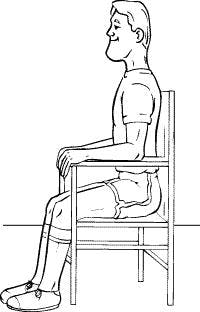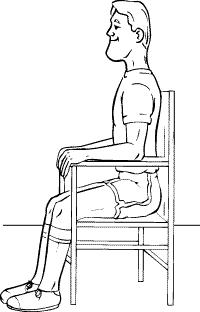Posture is one of those words that we all “understand” and yet most people can’t actually define.
For starters, let’s define posture.
Posture is the way you hold your body. Yup. That’s it.
Now we can start to get specific. There is good (or ideal) posture and there is bad posture.
This applies in any position. Sitting, standing etc. In this article we will be discussing sitting posture.
Sitting posture is affected by many things including both internal and external factors.
Internal factors are those within your body, such as strength, energy level, postural alignment and habit.
External factors are those outside your body such as the type of chair you are sitting in or the location of the surface you are trying to reach.
Before going into any further detail lets take a look at what proper sitting posture is.

There a few worthwhile points to consider about this sitting posture.
These are key factors in maintaining proper sitting posture.
Now take a look at this person sitting at their computer.

Note how one leg is bent too much with the other leg crossed over, her back is rounded, shoulders are elevated, neck is forward and head is tilted up. OUCH!
Sitting with any of these postural changes can lead to serious problems and pain. Things like knee pain, low back pain, shoulder tension and neck pain are common results from prolonged sitting in such posture.
However, it can often be very difficult to "fix" your posture after years of sitting a certain way. It becomes a habit and we feel uncomfortable trying to maintain correct posture.
This is not an easily rectified problem. It takes a lot of effort and exercise to retrain your body…but it is definitely worth it.
Here are some tips to help you correct your sitting posture.
- Make sure your feet are planted firmly on the floor. If your chair is too high…use a step stool
- Make sure your knees are lower than your hips. An easy way to do this in a computer chair is to tilt the chair forward. If you can’t tilt your chair…consider elevating your seat a little.
- Keep your core muscles (abdominals) engaged (just don’t hold your breath!)
- Maintain the natural curve of your lower back
- Keep your shoulders relaxed
- Pull your shoulder blades down and back a little to engage your upper back muscles
- Keep your head directly over your shoulders (don’t poke your head forward)
Try and get into this position regularly throughout the day. Even if you can’t maintain it for long, it will help train your body to get comfortable with this position.
I know. This is a lot to think about and even if you try…you may still not get to that "ideal" posture.
This is where your physical therapist plays such a pivotal role. Physical therapists are experts in movement and posture and can help you identify not only what your ideal posture should look like, but where you are going wrong and what you need to do to fix it.
Your physical therapist can help design an exercise program to work on the weak areas that are making it difficult to maintain good posture and give you personalized tips to help you keep your ideal posture and avoid pain throughout the day.
If you are experiencing any back, neck or knee pain and spend a good part of your day sitting…you owe it to yourself to consult with a physical therapist and get started on the road to improved posture and pain free living.

